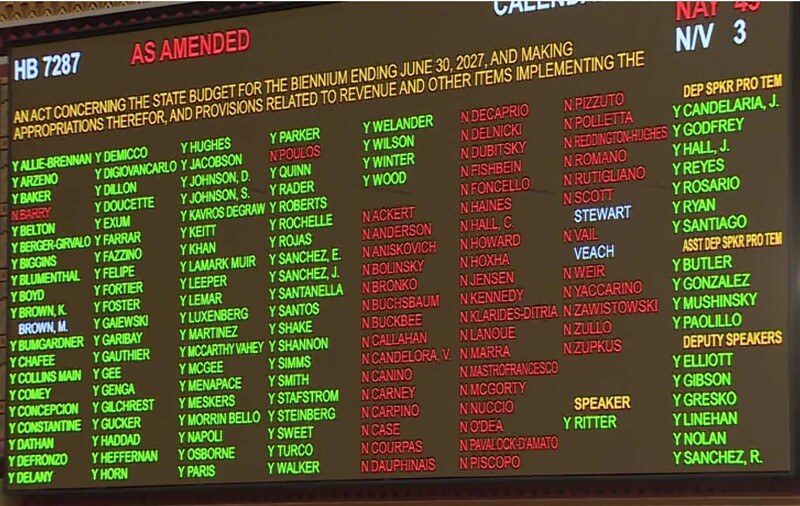Inside the $55.8B State Budget

The $55.8 billion budget adopted this week by the state legislature uses fiscal guardrail workarounds and business tax hikes to increase state spending by $2.6 billion over the next two years.
The budget features $357.6 million in business tax hikes through changes to the unitary tax, the extension of the so-called temporary corporate tax surcharge, and alterations to net operating loss carry forwards.
It boosts spending approximately $700 million over the budget Gov. Ned Lamont proposed at the beginning of the session.
About $1.2 billion that should go to paying down state employee pension liabilities—based on the historic 2017 reforms that restored the state’s fiscal health—will be diverted instead to fund much of the spending increases.
The two-year tax and spending package passed the House June 2 on a 99-49 vote, with two Democrats—Rep. Jill Barry (D-Glastonbury) and Rep. Chris Poulos (D-Southington)—joining Republicans in opposition.
It cleared the Senate the following day on a 25-11 party line vote.
‘Alarming’
CBIA president and CEO Chris DiPentima called the fiscal guardrail workarounds “the most alarming things in the budget.”
“That’s diverting about $1.2 billion that would have gone to paying down pension debt and continuing the remarkable progress we’ve made since the fiscal reforms were adopted,” he said.
“Policymakers are setting Connecticut up for a real problem in 2027 when the next budget is due—they’ll be looking at two choices, cutting programs or raising taxes, the same destructive options that hounded us throughout the last decade.
“This budget creates real uncertainty—not only for businesses, but for residents. What does it mean for future budget cycles? That’s the big question for Connecticut going forward.”

DiPentima said that by fiscal 2027, state government will spend about $6,873 per capita annually—about twice the national average and 42% above 2009 spending levels.
“The unchecked growth of Connecticut government spending far outpaces the growth of inflation, population, and household income,” he said.
“It’s unsustainable—and how do you convince residents or businesses to move here, to stay here, when we won’t make the hard decisions on spending or commit to long-term fiscal discipline?
“Just two years ago, the legislature passed the largest income tax cuts in state history, extended the fiscal guardrails, and avoided tax hikes on businesses—what changed?”
Tax Changes
The budget bill eliminates the $2.5 million cap on the amount a combined group’s tax, calculated on a combined unitary basis, can exceed the tax it would have paid on its nexus combined base tax, beginning with the 2025 income year.
This significant change will cost affected businesses a total of $133.1 million in fiscal year 2026 and $83.2 million in fiscal year 2027.
The bill also requires the increase in valuation allowance to be calculated based on the change reported in the combined group’s financial statements for the 2015 income year, rather than 2016 income year as current law requires.
The budget includes other business tax changes:
- Extends the 10% corporation business tax surcharge for three additional years, to the 2026 through 2028 income years, costing impacted businesses $128 million
- Sunsets the alternative net operating loss provision under the 2015 combined unitary reporting law, costing impacted businesses $8.3 million annually
- Rebases hospital provider tax calculations resulting in a significant increase, with uncertainty about repayments
- Requires telephone and telecommunications providers to add a five-cent fee to monthly subscriber bills to fund the Firefighters Cancer Relief Account (up to $4.5 million over two years)
- increases the cash refund a qualifying small biotechnology company may receive for research and development tax credits from 65% to 90%, capped at $1.5 million annually per company
- Creates a $500 refundable income tax credit for taxpayers who own a state-licensed family childcare home
- Creates a 20% refundable business tax credit for farm investments in eligible machinery, equipment, and buildings
- Establishes a new tax credit for contributions employers make to a qualifying employee’s Connecticut Higher Education Trust account equal to 25% of the employer’s contribution, capped at $500 per employee annually
- Creates a 50% tax credit for the amounts people, businesses, or entities paid to the University of Connecticut, capped at $500,000 per taxpayer annually
- Extends from 40 to 50 consecutive years the duration of the sales tax exemption for specified business services rendered between participants in certain kinds of joint ventures in the aircraft industry that existed before Jan. 1, 1986
- Eases the threshold for exempting annual dues and initiation fees from the state’s 10% dues tax from $100 to $250
Childcare Endowment
The budget takes $220 million from this fiscal year’s $2.4 billion surplus to create a new endowment that will pay for early childhood development programs.
DiPentima applauded the childcare initiative—a business community priority designed to address the growing labor participation gap between men and women—but questioned the mechanism used to fund it.
“There are more effective, viable, and sustainable solutions available to fund necessary initiatives and programs.”
CBIA’s Chris DiPentima
“There are more effective, viable, and sustainable solutions available to fund necessary initiatives and programs such as childcare,” he said.
“Lawmakers are sitting on a taxpayer-friendly blueprint for freeing up additional revenue, with a report they commissioned in 2021—and have largely ignored since—identifying between $600 million and $900 million in annual savings.
Along with childcare, the budget allocates additional funding for special education and Medicaid and sets aside funds to offset possible federal spending cuts expected later this year.
Bonding
Lawmakers also overwhelmingly approved a $9.7 billion bond package to finance school construction, transportation upgrades, and other capital projects over the next two fiscal years.
About 60% of the bonding package targets municipal school construction, transportation infrastructure, and clean water projects.
It also allocates about $1 billion to various housing initiatives, including $400 million for mixed-income developments, $100 million for middle housing, and $60 million for the state’s Time to Own program, which provides assistance to first-time homebuyers.
Other bonding items include:
- $242 million for the Community Investment Fund, which supports economic development initiatives and other projects in low-income cities and towns
- $200 million for Manufacturing Assistance Act programs, including $50 million earmarked for strategic defense initiatives
- $80 million for the Department of Economic and Community Development’s brownfield remediation and revitalization program, along with $50 million for the agency’s greyfield program
- $45 million for the Manufacturing Innovation Fund, a 50% increase over the last two-year budget
- $14 million for economically distressed municipalities
- $10 million for school districts in large cities that appear before the state’s Municipal Finance Advisory Commission
- $15 million for communities impacted by a catastrophic event
For more information, contact CBIA’s CBIA’s Chris Davis (860.244.1931) or Jenna Grasso (860.244.1169).
RELATED
EXPLORE BY CATEGORY
Stay Connected with CBIA News Digests
The latest news and information delivered directly to your inbox.



